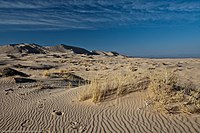
Photo from wikipedia
Abstract Aeolian transport of sand is abundant on modern-day Mars, as revealed by remote sensing measurements of the motion of dunes, and of the meter-scale ripples that mantle them. We… Click to show full abstract
Abstract Aeolian transport of sand is abundant on modern-day Mars, as revealed by remote sensing measurements of the motion of dunes, and of the meter-scale ripples that mantle them. We study a large-scale natural sand trap within the Meroe Patera dune field: a 1.8-km diameter crater which features a dune-free “shadow” in its lee. We compare the volume of sand trapped within this crater to the sand volume that would be expected to cover the area of the crater and its dune-free shadow behind it if the crater were not present. We find that the crater holds less sand than this “missing” volume would predict, implying that sand escapes from the crater over time. Modern day imagery shows an apparent lack of sand escaping from the Meroe crater, however, suggesting that changes in the wind regime at the site may have allowed sand to escape in the past. The persistence of an altered dune morphology all the way to the far downwind edge of the dune field suggests consistent wind conditions over the time of the crater-dune field interaction.
Journal Title: Icarus
Year Published: 2020
Link to full text (if available)
Share on Social Media: Sign Up to like & get
recommendations!